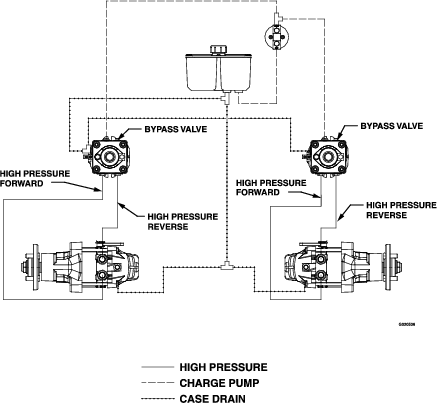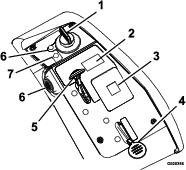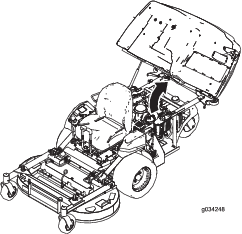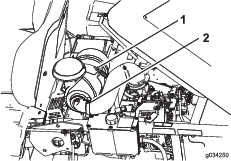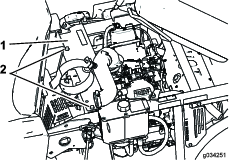| Maintenance Service Interval | Maintenance Procedure |
|---|---|
| Before each use or daily |
|
Introduction
This rotary-blade, riding lawn mower is intended to be used by residential homeowners or professional, hired operators. It is designed primarily for cutting grass on well-maintained lawns on residential or commercial properties. It is not designed for cutting brush or for agricultural uses.
Read this information carefully to learn how to operate and maintain your product properly and to avoid injury and product damage. You are responsible for operating the product properly and safely.
You may contact Toro directly at www.Exmark.com for product safety and operation training materials, accessory information, help finding a dealer, or to register your product.
Whenever you need service, genuine Toro parts, or additional information, contact an Authorized Service Dealer or Toro Customer Service and have the model and serial numbers of your product ready. Figure 1 identifies the location of the model and serial numbers on the product. Write the numbers in the space provided.
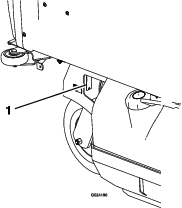
This manual identifies potential hazards and has safety messages identified by the safety-alert symbol (Figure 2), which signals a hazard that may cause serious injury or death if you do not follow the recommended precautions.

This manual uses 2 words to highlight information. Important calls attention to special mechanical information and Note emphasizes general information worthy of special attention.
It is a violation of California Public Resource Code Section 4442 or 4443 to use or operate the engine on any forest-covered, brush-covered, or grass-covered land unless the engine is equipped with a spark arrester, as defined in Section 4442, maintained in effective working order or the engine is constructed, equipped, and maintained for the prevention of fire.
Gross or Net Torque: The gross or net torque of this engine was laboratory rated by the engine manufacturer in accordance with the Society of Automotive Engineers (SAE) J1940 or J2723. As configured to meet safety, emission, and operating requirements, the actual engine torque on this class of mower will be significantly lower. Please refer to the engine manufacturer’s information included with the machine.
Warning
CALIFORNIA
Proposition 65 Warning
The engine exhaust from this product contains chemicals known to the State of California to cause cancer, birth defects, or other reproductive harm.
Battery posts, terminals, and related accessories contain lead and lead compounds, chemicals known to the State of California to cause cancer and reproductive harm. Wash hands after handling.
Use of this product may cause exposure to chemicals known to the State of California to cause cancer, birth defects, or other reproductive harm.
Safety
This machine has been designed in accordance with ANSI B71.4-2012.
General Safety
This product is capable of amputating hands and feet and of throwing objects. Always follow all safety instructions to avoid serious personal injury.
Using this product for purposes other than its intended use could prove dangerous to you and bystanders.
-
Always keep the roll bar in the fully raised and locked position and use the seat belt.
-
Do not operate the machine near drop-offs, ditches, embankments, water, or other hazards, or on slopes greater than 15 degrees.
-
Read and understand the contents of this Operator’s Manual before starting the engine.
-
Do not put your hands or feet near moving components of the machine.
-
Do not operate the machine without all guards and other safety protective devices in place and working on the machine.
-
Keep children and bystanders out of the operating area. Never allow children to operate the machine.
-
Stop the machine, shut off the engine, and remove the key before servicing, fueling, or unclogging the machine.
Improperly using or maintaining this machine can result in injury.
To reduce the potential for injury, comply with these safety instructions
and always pay attention to the safety-alert symbol ( ), which means Caution,
Warning, or Danger—personal safety instruction. Failure to comply
with these instructions may result in personal injury or death.
), which means Caution,
Warning, or Danger—personal safety instruction. Failure to comply
with these instructions may result in personal injury or death.
You can find additional safety information where needed throughout this manual.
Slope Indicator
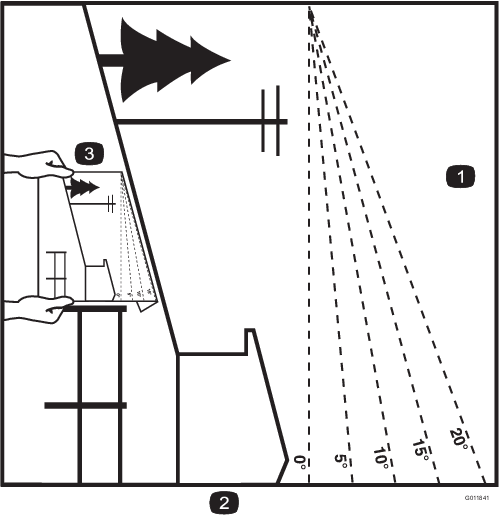
Safety and Instructional Decals
 |
Safety decals and instructions are easily visible to the operator and are located near any area of potential danger. Replace any decal that is damaged or missing. |






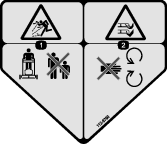

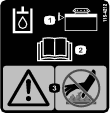
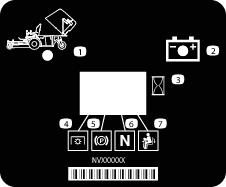
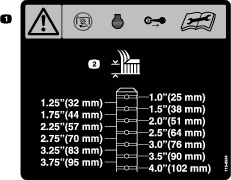


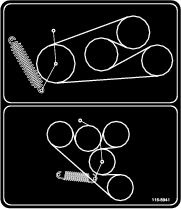

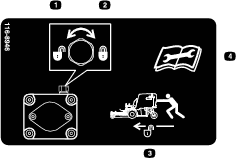





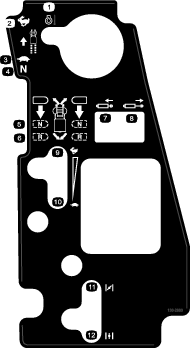
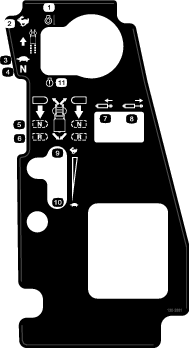
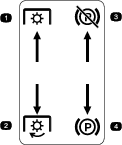

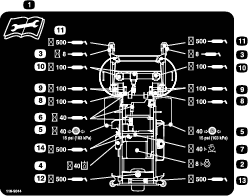
Product Overview
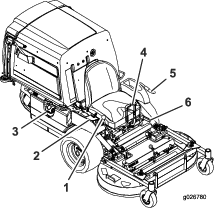
Control Panel
Key Switch
The key switch, used to start and shut off the engine, has 3 positions: OFF, RUN, and START. Refer to Starting the Engine.
Choke Control
Use the choke control to start a cold engine.
Throttle Control
The throttle controls the engine speed, and it has a continuous-variable setting from the SLOW to FAST position (Figure 5).
PTO-Engagement Lever
Use the PTO-engagement lever to engage the blades and the blower.
Motion-Control Levers
Use the motion-control levers to drive the machine forward, reverse, and turn either direction (Figure 4).
Speed-Control Lever
The speed-control lever sets maximum forward speed of the machine (Figure 1). Moving the speed-control lever rearward to the NEUTRAL position places the drive system into neutral.
Brake Lever
The brake lever engages a parking brake on the drive wheels (Figure 4).
Hour Meter
The hour meter records the number of hours the engine has operated. The hour meter is recording when the decimal point is flashing in the Hour/Voltage display. Use these times for scheduling regular maintenance (Figure 6).
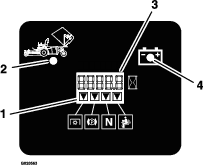
Battery-Indicator Light
If you turn the ignition key to the ON position for a few seconds, the battery voltage displays in the area where the hours are normally displayed.
The battery light turns on when the ignition is turned on and when the charge is below the correct operating level (Figure 6).
Safety-Interlock Indicators
There are symbols on the hour meter that indicate with a black triangle that the interlock component is positioned correctly (Figure 6).
Fuel-Shutoff Valve
Close the fuel-shutoff valve (under the hopper) when transporting or storing the mower.
Engine-Oil-Temperature Light and Buzzer
The engine-oil-temperature light monitors the temperature of the engine oil. An illuminated engine-oil-temperature light and intermittent buzzing sound signals that the engine is overheating.
Electronic-Control-Unit Malfunction-Indicator Light
The electronic-control unit (ECU) continuously monitors the operation of the EFI system.
If the system detects a problem or fault, the malfunction-indicator light (MIL) illuminates.
The MIL is located in the right console panel.
If the MIL illuminates, perform the initial troubleshooting checks; refer to the MIL section in .
If these checks do not correct the problem, further diagnosis and servicing by an Authorized Service Dealer is necessary.
Attachments/Accessories
A selection of Toro approved attachments and accessories is available for use with the machine to enhance and expand its capabilities. Contact your Authorized Service Dealer or Distributor or go to www.Exmark.com for a list of all approved attachments and accessories.
Note: Specifications and design are subject to change without notice.
| 42-inch Mower Deck | 48-inch Mower Deck | |
|---|---|---|
| Without Mower Deck | 108.2 cm (42.6 inches) | 108.2 cm (42.6 inches) |
| With Mower Deck | 109.7 cm (43.2 inches) | 125.0 cm (49.2 inches) |
| 42-inch Mower Deck | 48-inch Mower Deck | |
|---|---|---|
| Without Mower Deck | 170.9 cm (67.3 inches) | 170.9 cm (67.3 inches) |
| Mower Deck—Up | 209.3 cm (82.4 inches) | 207.6 cm (81.8 inches) |
| Mower Deck—Down | 233.2 cm (91.8 inches) | 240.0 cm (94.5 inches) |
| 42-inch Mower Deck | 48-inch Mower Deck |
|---|---|
| 130.0 cm (51.2 inches) | 130.0 cm (51.2 inches) |
| 42-inch Mower Deck | 48-inch Mower Deck |
|---|---|
| 517 kg (1,140 lb) | 531 kg (1,170 lb) |
Operation
Note: Determine the left and right sides of the machine from the normal operating position.
Before Operation
Before Operation Safety
General Safety
-
Never allow children or untrained people to operate or service the machine. Local regulations may restrict the age of the operator. The owner is responsible for training all operators and mechanics.
-
Become familiar with the safe operation of the equipment, operator controls, and safety signs.
-
Know how to stop the machine and shut off the engine quickly.
-
Check that operator-presence controls, safety switches, and shields are attached and functioning properly. Do not operate the machine unless they are functioning properly.
-
Before mowing, always inspect the machine to ensure that the blades, blade bolts, and cutting assemblies are in good working condition. Replace worn or damaged blades and bolts in sets to preserve balance.
-
Inspect the area where you will use the machine and remove all objects that the machine could throw.
-
Evaluate the terrain to determine the appropriate equipment and any attachments or accessories required to operate the machine properly and safely.
Fuel Safety
-
To avoid personal injury or property damage, use extreme care in handling fuel. Fuel vapors are flammable and explosive.
-
Extinguish all cigarettes, cigars, pipes, and other sources of ignition.
-
Use only an approved fuel container.
-
Do not remove the fuel cap or add fuel to the fuel tank while the engine is running or while hot.
-
Do not refuel the machine indoors.
-
Do not store the machine or fuel container where there is an open flame, spark, or pilot light, such as on a water heater or on other appliances.
-
Do not fill containers inside a vehicle or on a truck or trailer bed with a plastic liner. Always place containers on the ground, away from your vehicle before filling.
-
Remove the equipment from the truck or trailer and refuel it while it is on the ground. If this is not possible, then refuel from a portable container rather than a fuel-dispenser nozzle.
-
Do not operate the machine without the entire exhaust system in place and in proper working condition.
-
Keep the fuel-dispenser nozzle in contact with the rim of the fuel tank or container opening at all times until fueling is complete. Do not use a nozzle lock-open device.
-
If you spill fuel on your clothing, change your clothing immediately. Wipe up any fuel that spills.
-
Never overfill the fuel tank. Replace the fuel cap and tighten it securely.
-
Store fuel in an approved container and keep it out of the reach of children. Never buy more than a 30-day supply of fuel.
-
Do not fill the fuel tank completely full. Add fuel to the fuel tank until the level is 6 to 13 mm (1/4 to 1/2 inch) below the bottom of the filler neck. This empty space in the tank allows fuel to expand.
-
Avoid prolonged breathing of vapors.
-
Keep your face away from the nozzle and fuel tank opening.
-
Avoid contact with skin; wash off spills with soap and water.
-
Adding Fuel
Recommended Fuel
-
For best results, use only clean, fresh (less than 30 days old), unleaded gasoline with an octane rating of 87 or higher ((R+M)/2 rating method).
-
Ethanol: Gasoline with up to 10% ethanol (gasohol) or 15% MTBE (methyl tertiary butyl ether) by volume is acceptable. Ethanol and MTBE are not the same. Gasoline with 15% ethanol (E15) by volume is not approved for use. Never use gasoline that contains more than 10% ethanol by volume, such as E15 (contains 15% ethanol), E20 (contains 20% ethanol), or E85 (contains up to 85% ethanol). Using unapproved gasoline may cause performance problems and/or engine damage which may not be covered under warranty.
-
Do not use gasoline containing methanol.
-
Do not store fuel either in the fuel tank or fuel containers over the winter unless you use a fuel stabilizer.
-
Do not add oil to gasoline.
Using Stabilizer/Conditioner
Use a fuel stabilizer/conditioner in the machine to provide the following benefits:
-
Keeps fuel fresh longer when used as directed by the fuel-stabilizer manufacturer
-
Cleans the engine while it runs
-
Eliminates gum-like varnish buildup in the fuel system, which causes hard starting
Important: Do not use fuel additives containing methanol or ethanol.
Add the correct amount of fuel stabilizer/conditioner to the fuel.
Note: A fuel stabilizer/conditioner is most effective when mixed with fresh fuel. To minimize the chance of varnish deposits in the fuel system, use fuel stabilizer at all times.
Filling the Fuel Tank
-
Park the machine on a level surface.
-
Engage the parking brake.
-
Shut off the engine and remove the key.
-
Clean around the fuel-tank cap.
-
Fill the fuel tank to the bottom of the filler neck (Figure 7).
Note: Do not fill the fuel tank completely full. The empty space in the tank allows the fuel to expand.

Performing Daily Maintenance
Before starting the machine each day, perform the Each Use/Daily procedures listed in .
Breaking in a New Machine
New engines take time to develop full power. Mower decks and drive systems have higher friction when new, placing additional load on the engine. Allow 40 to 50 hours of break-in time for new machines to develop full power and best performance.
Raising the Mower Deck into the Service Position
-
Park the machine on a level surface, disengage the PTO, and engage the parking brake.
-
Shut off the engine, remove the key, and wait for all moving parts to stop before leaving the operating position.
-
Release the mower deck locking pins on each side (Figure 8).
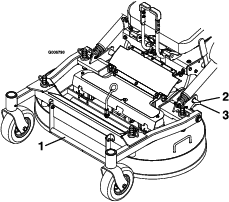
-
Using the deck-lift handle, lift the deck and latch it in the raised position (latch is located at front center of seat) as shown in Figure 9.
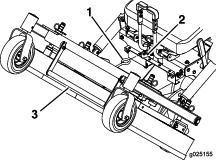
Warning
Engaging the PTO with a deck in the raised position can result in a serious injury or property damage.
Always lower and lock the mower deck in the operation position before engaging the PTO.
Lowering the Mower Deck to the Operating Position
-
While firmly holding onto deck-lift handle, unhook the mower-deck latch from the machine and slowly lower the mower deck to the ground (Figure 9).
-
Push the deck-locking pins inward and rotate them forward to securely lock the mower deck in the lowered position (Figure 8).
Warning
Operating the machine without the locking pins securely latched can result in the mower deck folding up unexpectedly, causing serious injury.
Always operate the machine with the locking pins securely latched.
Adjusting the Fill Reduction System (FRS) Baffles
The fill reduction system has been designed to allow you to reduce the amount of clippings collected by varying degrees. The advantages include less frequent emptying of the hopper and the return of nutrients to the soil.
The following are possible configurations:
-
Baffles open with standard blades—maximum collection
-
Baffles closed with standard blades—partial mulching
-
Baffles closed with mulch blades—intermediate mulching
-
Mulch plug installed with mulch blades—complete mulching (requires mulch kit)
Adjust the FRS baffles as follows:
-
Park the machine on a level surface, disengage the PTO, and engage the parking brake.
-
Shut off the engine, remove the key, and wait for all moving parts to stop before leaving the operating position.
-
Remove the hairpin cotters and clevis pins from both sides of the PTO guard (Figure 10).
-
Fold the guard forward.
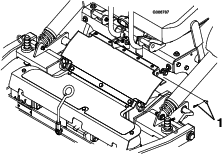
-
Loosen the locknuts on the rear studs of the FRS baffles.
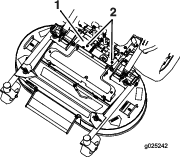
-
Raise the mower deck; refer to Raising the Mower Deck into the Service Position.
-
Remove the bolt and washer at the front of each FRS baffle (Figure 12).
-
Rotate the baffles into the desired position and install the bolt and washer.
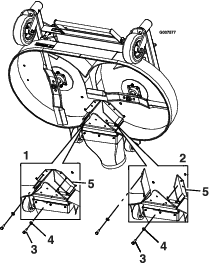
-
Lower the mower deck; refer to Lowering the Mower Deck to the Operating Position.
-
Slightly tighten the locknuts on the rear studs of the FRS baffles.
Note: The locknuts on the rear studs may be left slightly loose if you anticipate adjusting the baffle frequently.
-
Install the PTO guard using the clevis pins and hairpin cotters removed in step 3.
Using the Safety-Interlock System
Warning
If the safety-interlock switches are disconnected or damaged, the machine could operate unexpectedly, causing personal injury.
-
Do not tamper with the interlock switches.
-
Check the operation of the interlock switches daily and replace any damaged switches before operating the machine.
Understanding the Safety-Interlock System
The safety-interlock system is designed to prevent the engine from starting unless:
-
The parking brake is engaged.
-
The PTO-engagement lever is disengaged.
-
The speed-control lever is in the NEUTRAL position
The safety-interlock system is designed to shut off the engine when you rise from the seat when the PTO is engaged.
The hour meter has symbols to notify you when the interlock component is in the correct position. When the component is in the correct position, a triangle lights up in the corresponding square.

Testing the Safety-Interlock System
Test the safety-interlock system before you use the machine each time. If the safety system does not operate as described below, have an Authorized Service Dealer repair the safety system immediately.
-
Sit on the seat, engage the parking brake, move the PTO-engagement lever to the ON position, and move the speed-control lever to the NEUTRAL position. Try starting the engine; the engine should not start.
-
Sit on the seat, engage the parking brake, and move the PTO-engagement lever to the OFF position. Move the speed-control lever out of the NEUTRAL position. Try starting the engine; the engine should not start.
-
Sit on the seat, disengage the parking brake, move the PTO-engagement lever to the OFF position, and move the speed-control lever to the NEUTRAL position. Try starting the engine; the engine should not start.
-
Sit on the seat, engage the parking brake, move the PTO-engagement lever to the OFF position, and move the speed-control lever to the NEUTRAL position. Now start the engine. While the engine is running, release the parking brake, engage the PTO-engagement lever, and rise slightly from the seat; the engine should shut off.
-
Sit on the seat, engage the parking brake, move the PTO-engagement lever to the OFF position, and move the speed-control lever to the NEUTRAL position. Now start the engine. Move the speed-control lever forward; the engine should shut off.
During Operation
During Operation Safety
General Safety
-
The owner/operator can prevent and is responsible for accidents that may cause personal injury or property damage.
-
Wear appropriate clothing, including eye protection; long pants; slip-resistant, substantial footwear; and hearing protection. Tie back long hair and do not wear loose jewelry.
-
Use your full attention while operating the machine. Do not engage in any activity that causes distractions; otherwise, injury or property damage may occur.
-
Do not operate the machine while ill, tired, or under the influence of alcohol or drugs.
-
Never carry passengers on the machine and keep bystanders and pets away from the machine during operation.
-
Operate the machine only in good visibility to avoid holes or hidden hazards.
-
Avoid mowing on wet grass. Reduced traction could cause the machine to slide.
-
Ensure that all drives are in neutral, the parking brake is engaged, and you are in the operating position before you start the engine.
-
Keep your hands and feet away from the cutting units. Keep clear of the discharge opening at all times.
-
Look behind and down before backing up to be sure of a clear path.
-
Use care when approaching blind corners, shrubs, trees, or other objects that may obscure your vision.
-
Do not mow near drop-offs, ditches, or embankments. The machine could suddenly roll over if a wheel goes over the edge or if the edge gives way.
-
Stop the blades whenever you are not mowing.
-
Stop the machine, shut off the engine, remove the key, and inspect the blades after striking an object or if there is an abnormal vibration in the machine. Make all necessary repairs before resuming operation.
-
Slow down and use caution when making turns and crossing roads and sidewalks with the machine. Always yield the right-of-way.
-
Disengage the drive to the cutting unit, shut off the engine, and remove the key before adjusting the height of cut (unless you can adjust it from the operating position).
-
Never run an engine in an area where exhaust gases are enclosed.
-
Never leave a running machine unattended.
-
Before leaving the operating position (including to empty the catchers or to unclog the chute), do the following:
-
Stop the machine on level ground.
-
Disengage the power takeoff and lower the attachments.
-
Engage the parking brake.
-
Shut off the engine and remove the key.
-
Wait for all moving parts to stop.
-
-
Do not operate the machine when there is the risk of lightning.
-
Do not use the machine as a towing vehicle unless it has a hitch installed.
-
Do not change the governor speed or overspeed the engine.
-
Use only accessories and attachments approved by Toro.
-
This machine produces sound levels in excess of 85 dBA at the operator’s ear and can cause hearing loss through extended periods of exposure.

Rollover Protection System (ROPS) Safety
-
Do not remove the roll bar from the machine.
-
Ensure that the seat belt is attached and that you can release it quickly in an emergency.
-
Always wear your seat belt when the roll bar is up.
-
Check carefully for overhead obstructions and do not contact them.
-
Keep the roll bar in safe operating condition by thoroughly inspecting it periodically for damage and keeping all the mounting fasteners tight.
-
Replace a damaged roll bar. Do not repair or alter it.
Slope Safety
-
Slopes are a major factor related to loss of control and rollover accidents, which can result in severe injury or death. The operator is responsible for safe slope operation. Operating the machine on any slope requires extra caution. Before using the machine on a slope, do the following:
-
Review and understand the slope instructions in the manual and on the machine.
-
Use an angle indicator to determine the approximate slope angle of the area.
-
Never operate on slopes greater than 15 degrees.
-
Evaluate the site conditions of the day to determine if the slope is safe for machine operation. Use common sense and good judgment when performing this evaluation. Changes in the terrain, such as moisture, can quickly affect the operation of the machine on a slope.
-
-
Identify hazards at the base of the slope. Do not operate the machine near drop-offs, ditches, embankments, water, or other hazards. The machine could suddenly roll over if a wheel goes over the edge or the edge collapses. Keep a safe distance (twice the width of the machine) between the machine and any hazard. Use a walk-behind machine or a hand trimmer to mow the grass in these areas.
-
Avoid starting, stopping, or turning the machine on slopes. Avoid making sudden changes in speed or direction; turn slowly and gradually.
-
Do not operate a machine under any conditions where traction, steering, or stability is in question. Be aware that operating the machine on wet grass, across slopes, or downhill may cause the machine to lose traction. Loss of traction to the drive wheels may result in sliding and a loss of braking and steering. The machine can slide even if the drive wheels are stopped.
-
Remove or mark obstacles such as ditches, holes, ruts, bumps, rocks, or other hidden hazards. Tall grass can hide obstacles. Uneven terrain could overturn the machine.
-
Use extra care while operating with accessories or attachments, such as grass-collection systems. These can change the stability of the machine and cause a loss of control. Follow directions for counterweights.
-
If possible, keep the deck lowered to the ground while operating on slopes. Raising the deck while operating on slopes can cause the machine to become unstable.
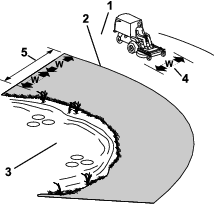
Operating the Parking Brake
Always engage the parking brake when you stop the machine or leave it unattended.
Engaging the Parking Brake
Park the machine on a level surface.
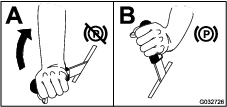
Disengaging the Parking Brake
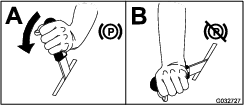
Operating the PTO-Engagement Lever
The PTO-engagement lever starts and stops the mower blades and blower.
Engaging the PTO-Engagement Lever
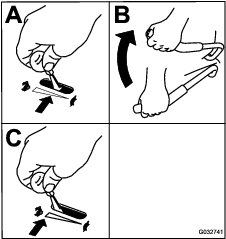
Disengaging the PTO-Engagement Lever
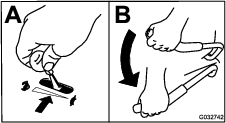
Operating the Throttle
You can move the throttle control between FAST and SLOW positions (Figure 20).
Always use the FAST position when engaging the PTO.

Starting the Engine
-
Move the speed-control lever to the NEUTRAL position.
-
Engage the parking brake; refer to Engaging the Parking Brake.
-
Move the PTO-engagement lever to the OFF position (Figure 21).
-
Move the throttle lever midway between the SLOW and FAST positions.
-
For EFI machines: Move the choke control to the CLOSED/ON position. On a warm engine, leave the choke in the OPEN/OFF position.
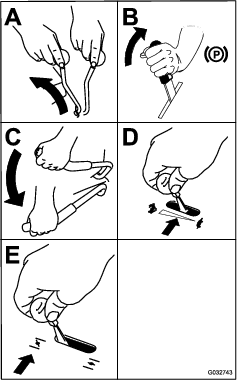
-
Turn the key to the START position (Figure 21). When the engine starts, release the key.
Important: Do not engage starter for more than 5 seconds at a time. If the engine fails to start, wait 15 seconds between attempts. Failure to follow these instructions can burn out the starter motor.
Note: You may need multiple attempts to start the engine the first time after adding fuel to an empty fuel system.
-
If the choke is in the CLOSED/ON position, gradually return choke to the OPEN/OFF position as the engine warms up.
Shutting Off the Engine
Caution
Children or bystanders may be injured if they move or attempt to operate the machine while it is unattended.
Always remove the key and engage the parking brake when leaving the machine unattended.
-
Disengage the PTO.
-
Move the speed-control lever to the NEUTRAL position.
-
Engage the parking brake.
-
Place the throttle in the middle position.
-
Let the engine idle for 15 seconds, then turn the key switch to the OFF position and remove the key.
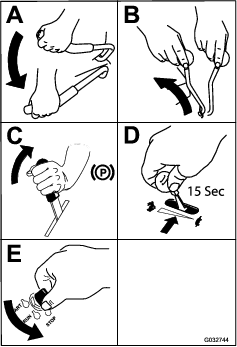
Driving the Machine
The throttle control regulates the engine speed as measured in rpm (revolutions per minute). Place the throttle control in the FAST position for best performance. Always operate in the full throttle position when mowing.
Warning
The machine can spin very rapidly. You may lose control of the machine and cause personal injury or damage to the machine.
-
Use caution when making turns.
-
Slow the machine down before making sharp turns.
Driving Forward
Note: To begin movement (forward or backward), sit on the seat and disengage the parking-brake lever before you move the speed-control lever forward, otherwise the engine shuts off.
To stop the machine, pull the speed control lever to the NEUTRAL position.
-
Start the engine.
-
Disengage the parking brake; refer to Disengaging the Parking Brake.
-
To move forward in a straight line move the speed control lever forward.
Note: The machine moves faster the farther that you move the speed control lever away from the NEUTRAL position.
-
To turn left or right, pull 1 of the steering levers back toward neutral in the direction desired.
-
To stop the machine, pull the speed control lever back to the NEUTRAL position.
Driving Backward
-
To move rearward in a straight line, pull both steering levers rearward equally.
To turn left or right, release pressure on the steering lever toward the direction desired.
-
To stop the machine, release the steering levers to the neutral position.
Adjusting the Height of Cut
The cutting height of the mower deck is adjusted from 2.5 to 10.2 cm (1 to 4 inches) in 6.3 mm (1/4 inch) increments.
-
Park the machine on a level surface, move the speed-control lever to the NEUTRAL position, disengage the PTO, and engage the parking brake.
-
Shut off the engine, remove the key, and wait for all moving parts to stop before leaving the operating position.
-
Using the mower-deck handle, raise the mower deck, and move the cotter pins to the desired height-of-cut position. Repeat for the opposite side.
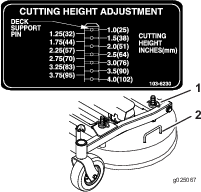
Emptying the Hopper
A full hopper is indicated by a buzzer located behind the seat, in the hopper. Empty the hopper when the buzzer sounds to prevent clogging of the blower or the mower deck.
-
Park the machine on a level surface, move the speed-control lever to the NEUTRAL position, disengage the PTO, and engage the parking brake.
-
Shut off the engine, remove the key, and wait for all moving parts to stop before leaving the operating position.
-
Lift the rear door up and allow it to rest on top of the hopper.
-
Using the handles at the lower front of the hopper, raise the hopper to dump the contents.
-
Lower the hopper and close the hopper door.
Operating Tips
Using the Fast Throttle Setting
For best mowing and maximum air circulation, operate the engine at the FAST position. Air is required to thoroughly cut grass clippings, so do not set the height-of-cut so low as to totally surround the mower deck in uncut grass. Always try to have 1 side of the mower deck free from uncut grass, which allows air to be drawn into the mower deck.
Cutting a Lawn for the First Time
Cut grass slightly longer than normal to ensure that the cutting height of the mower deck does not scalp any uneven ground. However, the cutting height used in the past is generally the best one to use. When cutting grass longer than 15 cm (6 inches) tall, you may want to cut the lawn twice to ensure an acceptable quality of cut.
Cutting a Third of the Grass Blade
It is best to cut only about a third of the grass blade. Cutting more than that is not recommended unless grass is sparse, or it is late fall when grass grows more slowly.
Alternating the Mowing Direction
Alternate the mowing direction to keep the grass standing straight. This also helps disperse clippings, which enhances decomposition and fertilization.
Mowing at Correct Intervals
Grass grows at different rates at different times of the year. To maintain the same cutting height, mow more often in early spring. As the grass growth rate slows in mid summer, mow less frequently. If you cannot mow for an extended period, first mow at a high cutting height, then mow again 2 days later at a lower height setting.
Using a Slower Cutting Speed
To improve cut quality, use a slower ground speed in certain conditions.
Avoiding Cutting Too Low
When mowing uneven turf, raise the cutting height to avoid scalping the turf.
Stopping the Machine
If you must stop the forward motion of the machine while mowing, a clump of grass clippings may drop onto your lawn. To avoid this, move onto a previously cut area with the blades engaged or you can disengage the mower deck while moving forward.
Keeping the Underside of the Mower Deck Clean
Clean clippings and dirt from the underside of the mower deck after each use. If grass and dirt build up inside the mower deck, cutting quality will eventually become unsatisfactory.
Maintaining the Blade(s)
Maintain a sharp blade throughout the cutting season because a sharp blade cuts cleanly without tearing or shredding the grass blades. Tearing and shredding turns grass brown at the edges, which slows growth and increases the chance of disease. Check the mower blades after each use for sharpness, and for any wear or damage. File down any nicks and sharpen the blades as necessary. If a blade is damaged or worn, replace it immediately with a genuine Toro replacement blade.
After Operation
After Operation Safety
General Safety
-
Clean grass and debris from the cutting units, mufflers, and engine compartment to help prevent fires. Clean up oil or fuel spills.
-
Shut off the fuel and remove the key before storing or transporting the machine.
-
Disengage the drive to the attachment whenever you are transporting or not using the machine.
-
Allow the engine to cool before storing the machine in any enclosure.
-
Never store the machine or fuel container where there is an open flame, spark, or pilot light, such as on a water heater or on other appliances.
Clearing the Hopper Screen
Remove the screen by firmly lifting the screen handles (Figure 24).
Pull the screen toward the back to remove it. As needed, gently tap the screen to remove debris.
Note: Excessive buildup on the screen can cause the blower to plug.
Note: In conditions where the screen clogs quickly, you can turn and install the front removable screen panel under the primary screen to allow free air flow from the hopper.
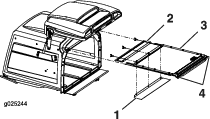
Using the Drive-Wheel Release Valves
Warning
Hands may become entangled in the rotating drive components below the engine deck, which could result in serious injury.
Shut off the engine, remove the key, and allow all moving parts to stop before accessing the drive-wheel-release valves.
Warning
The engine and hydraulic-drive units can become very hot. Touching a hot engine or hydraulic-drive units can cause severe burns.
Allow the engine and hydraulic-drive units to cool completely before accessing the drive-wheel-release valves.
The drive-wheel release valves are located on the top, left, front corner of the hydrostatic pumps.
-
Move the speed-control lever to the NEUTRAL position to stop the machine.
-
Disengage the PTO lever, engage the parking brake, shut off the engine, and wait for all moving parts to stop.
-
Tilt the seat up to gain access to the pumps.
-
Rotate both release valves 1 turn counterclockwise to release the drive system.
Note: This allows the hydraulic fluid to bypass the pump, enabling the wheels to turn.
-
Disengage the parking brake before pushing the machine.
Note: Do not tow the machine.
-
Rotate the valves clockwise to run the machine.
Note: Do not overtighten the valves.
Transporting the Machine
Use a heavy-duty trailer or truck to transport the machine. Use a full-width ramp. Ensure that the trailer or truck has all the necessary brakes, lighting, and marking as required by law. Please carefully read all the safety instructions. Knowing this information could help you or bystanders avoid injury. Refer to your local ordinances for trailer and tie-down requirements.
Warning
Driving on the street or roadway without turn signals, lights, reflective markings, or a slow-moving-vehicle emblem is dangerous and can lead to accidents, causing personal injury.
Do not drive the machine on a public street or roadway.
Selecting a Trailer
Warning
Loading a machine onto a trailer or truck increases the possibility of tip-over and could cause serious injury or death (Figure 25).
-
Use only a full-width ramp; do not use individual ramps for each side of the machine.
-
Do not exceed a 15-degree angle between the ramp and the ground or between the ramp and the trailer or truck.
-
Ensure that the length of the ramp is at least 4 times as long as the height of the trailer or truck bed to the ground. This ensures that the ramp angle does not exceed 15 degrees on flat ground.
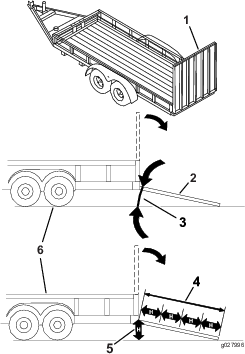
Loading the Machine
Warning
Loading a machine onto a trailer or truck increases the possibility of tip-over and could cause serious injury or death.
-
Use extreme caution when operating a machine on a ramp.
-
Back the machine up the ramp and drive it forward down the ramp.
-
Avoid sudden acceleration or deceleration while driving the machine on a ramp as this could cause a loss of control or a tip-over situation.
-
If using a trailer, connect it to the towing vehicle and connect the safety chains.
-
If applicable, connect the trailer brakes and lights.
-
Lower the ramp, ensuring that the angle between the ramp and the ground does not exceed 15 degrees (Figure 25).
-
Back the machine up the ramp (Figure 26).

-
Shut off the engine, remove the key, and engage the parking brake.
-
Securely fasten the machine to the trailer or truck with straps, chains, cable, or ropes down and outward from the machine. Refer to local regulations for tie-down requirements.
Maintenance
Recommended Maintenance Schedule(s)
| Maintenance Service Interval | Maintenance Procedure |
|---|---|
| After the first 50 hours |
|
| After the first 100 hours |
|
| Before each use or daily |
|
| Every 40 hours |
|
| Every 50 hours |
|
| Every 100 hours |
|
| Every 150 hours |
|
| Every 160 hours |
|
| Every 200 hours |
|
| Every 250 hours |
|
| Every 500 hours |
|
| Every 2,000 hours |
|
| Monthly |
|
| Yearly |
|
| Yearly or before storage |
|
Important: Refer to your engine owner’s manual for additional maintenance procedures.
Caution
If you leave the key in the switch, someone could accidently start the engine and seriously injure you or other bystanders.
Shut off the engine and remove the key from the switch before you perform any maintenance.
Pre-Maintenance Procedures
Maintenance Safety
-
Before repairing the machine do the following:
-
Disengage the drives.
-
Engage the parking brake.
-
Shut off the engine and remove the key.
-
Disconnect the spark-plug wire.
-
-
Park the machine on a level surface.
-
Clean grass and debris from the cutting unit, drives, mufflers, and engine to help prevent fires.
-
Clean up oil or fuel spills.
-
Do not allow untrained personnel to service the machine.
-
Use jack stands to support the machine and/or components when required.
-
Carefully release pressure from components with stored energy.
-
Disconnect the battery or remove the spark-plug wire before making any repairs. Disconnect the negative terminal first and the positive terminal last. Connect the positive terminal first and negative last.
-
Use care when checking the blades. Wrap the blade(s) or wear thickly padded gloves, and use caution when servicing them. Only replace blades; do not straighten or weld them.
-
Keep your hands and feet away from moving parts. If possible, do not make adjustments with the engine running.
-
Keep all parts in good working condition and all hardware tightened, especially the blade-attachment bolts. Replace all worn or damaged decals.
-
Never interfere with the intended function of a safety device or reduce the protection provided by a safety device. Check their proper operation regularly.
-
Use only genuine Toro replacement parts.
-
Check the parking brake operation frequently. Adjust and service as required.
Lubrication
Lubricating the Machine
| Maintenance Service Interval | Maintenance Procedure |
|---|---|
| Before each use or daily |
|
| Every 40 hours |
|
| Every 100 hours |
|
| Yearly |
|
Grease Type: No. 2 lithium or molybdenum grease
-
Park the machine on a level surface, disengage the PTO, and engage the parking brake.
-
Shut off the engine, remove the key, and wait for all moving parts to stop before leaving the operating position.
-
Clean the grease fittings with a rag. Make sure to scrape any paint off the front of the fitting(s).
-
Connect a grease gun to the fitting. Pump grease into the fittings until grease begins to ooze out of the bearings.
-
Wipe up any excess grease.
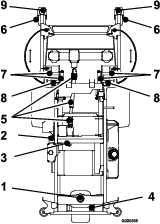
Lubricating the Pump-Belt Idler Arm
Lubricating the Caster-Wheel Hubs
| Maintenance Service Interval | Maintenance Procedure |
|---|---|
| Yearly |
|
-
Park the machine on a level surface, disengage the blade-control switch, and engage the parking brake.
-
Shut off the engine, remove the key, and wait for all moving parts to stop before leaving the operating position.
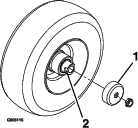
-
Raise the mower for access.
-
Remove the caster wheel from the caster forks.
-
Remove the seal guards from the wheel hub.
-
Remove a spacer nut from the axle assembly in the caster wheel.
Note: Thread-locking adhesive has been applied to lock the spacer nuts to the axle.
-
Remove the axle (with the other spacer nut still assembled to it) from the wheel assembly.
-
Pry out seals and inspect bearings for wear or damage and replace if necessary.
-
Pack the bearings with a general-purpose grease.
-
Insert 1 bearing and 1 new seal into the wheel.
-
If the axle assembly is missing both spacer nuts, apply a thread-locking adhesive to 1 spacer nut and thread it onto the axle with the wrench flats facing outward.
Note: Do not thread the spacer nut all of the way onto the end of the axle. Leave approximately 3 mm (1/8 inch) from the outer surface of the spacer nut to the end of the axle inside the nut.
-
Insert the assembled nut and axle into the wheel on the side of the wheel with the new seal and bearing.
-
With the open end of the wheel facing up, fill the area inside the wheel around the axle full of general-purpose grease.
-
Insert the second bearing and new seal into the wheel.
-
Apply a thread-locking adhesive to the second spacer nut, and thread it onto the axle with the wrench flats facing outward.
-
Torque the nut to 8 to 9 N∙m (75 to 80 in-lb), loosen, then torque to 2 to 3 N∙m (20 to 25 in-lb).
Note: Make sure that the axle does not extend beyond either nut.
-
Install the seal guards over the wheel hub, and insert the wheel into the caster fork.
-
Install the caster bolt and tighten the nut fully.
Important: To prevent seal and bearing damage, check the bearing adjustment often. Spin the caster tire. The tire should not spin freely (more than 1 or 2 revolutions) or have any side play. If the wheel spins freely, adjust the torque on the spacer nut until there is a slight amount of drag. Apply another layer of thread-locking adhesive.
Lubricating the Brake-Handle Pivot
| Maintenance Service Interval | Maintenance Procedure |
|---|---|
| Every 160 hours |
|
-
Park the machine on a level surface, disengage the PTO, and engage the parking brake.
-
Shut off the engine, remove the key, and wait for all moving parts to stop before leaving the operating position.
-
Lubricate the bronze bushings on the brake-handle pivot with a spray type lubricant or light oil (Figure 32).
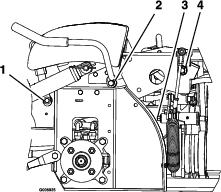
Lubricating the Brake-Rod Bushings and Steering-Linkage Rod Ends
| Maintenance Service Interval | Maintenance Procedure |
|---|---|
| Every 160 hours |
|
-
Park the machine on a level surface, disengage the PTO, and engage the parking brake.
-
Shut off the engine, remove the key, and wait for all moving parts to stop before leaving the operating position.
-
Unlatch the seat latch and tilt the seat up.
-
Lubricate the bronze bushings on each end of the brake rod shaft with a spray type lubricant or a light oil.
Note: The bushings are located to the inside of the flange bearings.
-
Lubricate each end of both steering linkage rods with a spray lubricant or a light oil.
Changing the Gearbox Oil
| Maintenance Service Interval | Maintenance Procedure |
|---|---|
| After the first 50 hours |
|
| Every 100 hours |
|
| Every 2,000 hours |
|
-
Park the machine on a level surface, disengage the PTO, and engage the parking brake.
-
Shut off the engine, remove the key, and wait for all moving parts to stop before leaving the operating position.
-
Remove the blades that are attached to the gearbox; refer toRemoving the Blades.
-
Remove the gearbox and drive-shaft assembly from the mower deck. Retain the hardware for use later.
-
Remove the large oil drain plug on the front of each of the 3 gearbox sections and drain the oil (Figure 33).
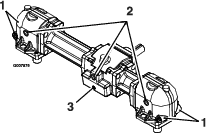
-
Remove the small magnetic plugs and wipe away any material accumulated on the plugs.
-
Apply a Teflon® pipe sealant to all small magnetic plugs and install them into the gearbox.
-
Install the gearbox and drive-shaft assembly to the mower deck.
-
Fill the gearbox with Mobil® SHC (synthetic) 75W-90 gear lube oil until level with oil drain/fill plug.
Note: Each of the gearbox sections must be filled separately.
Note: Keep the mower deck level to the ground when filling the gearbox with oil. Do not fill the gearbox with the mower deck raised in the service position.
-
Apply a Teflon pipe sealant to the 3 large oil plugs and install them into the gearbox.
Engine Maintenance
Engine Safety
-
Shut off the engine before checking the oil or adding oil to the crankcase.
-
Keep your hands, feet, face, clothing, and other body parts away the muffler and other hot surfaces.
Servicing the Air Cleaner
| Maintenance Service Interval | Maintenance Procedure |
|---|---|
| Every 150 hours |
|
| Every 250 hours |
|
| Every 500 hours |
|
Note: Check the filters more frequently if the operating conditions are extremely dusty or sandy.
Removing the Filters
-
Park the machine on a level surface, disengage the blade-control switch (PTO), and engage the parking brake.
-
Shut off the engine, remove the key, and wait for all moving parts to stop before leaving the operating position.
-
Release the latches on the air cleaner and pull the air-cleaner cover off the air-cleaner body (Figure 34).
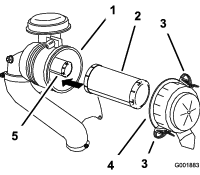
-
Clean the inside of the air-cleaner cover with compressed air.
-
Gently slide the primary filter out of the air-cleaner body (Figure 34).
Note: Avoid knocking the filter into the side of the body.
-
Remove the safety filter only to replace it.
Important: Do not attempt to clean the safety filter. If the safety filter is dirty, then the primary filter is damaged. Replace both filters.
-
Inspect the primary filter for damage by looking into the filter while shining a bright light on the outside of the filter.
Note: Holes in the filter appear as bright spots. If the filter is damaged, discard it.
Inspecting the Filters
-
Inspect the safety filter. If it is dirty, replace both the safety and primary filters.
Important: Do not attempt to clean the safety filter. If the safety filter is dirty, then the primary filter is damaged.
-
Inspect the primary filter for damage by looking into the filter while shining a bright light on the outside of the filter. If the primary filter is dirty, bent, or damaged, replace it.
Note: Holes in the filter appear as bright spots. Do not clean the primary filter.
Installing the Filters
Important: To prevent engine damage, always operate the engine with both air filters and the cover installed.
-
If you are installing new filters, check each filter for shipping damage.
Note: Do not use a damaged filter.
-
If you are replacing the inner filter, carefully slide it into the filter body (Figure 34).
-
Carefully slide the primary filter over the safety filter (Figure 34).
Note: Ensure that the primary filter is fully seated by pushing on the outer rim while installing it.
Important: Do not press on the soft, inside area of the filter.
-
Install the air-cleaner cover and secure the latches (Figure 34).
Servicing the Engine Oil
Engine-Oil Specifications
Oil Type: Detergent oil (API service class SJ or higher)
Oil Capacity (Non-EFI engines): with a filter change, 1.8 L (61 fl oz); with no filter change, 1.6 L (54 fl oz)
Oil Capacity (EFI engines): with a filter change, 1.9 L (64 fl oz); with no filter change, 1.6 L (54 fl oz)
Viscosity: See the table below.
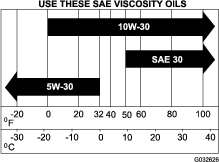
Checking the Engine-Oil Level
| Maintenance Service Interval | Maintenance Procedure |
|---|---|
| Before each use or daily |
|
Note: Check the oil when the engine is cold.
Important: Do not overfill the crankcase with oil because damage to the engine may result. Do not run engine with oil below the low mark because the engine may be damaged.
-
Park the machine on a level surface, move the speed-control lever to the NEUTRAL position, disengage the PTO, and engage the parking brake.
-
Shut off the engine, remove the key, and wait for all moving parts to stop before leaving the operating position.
Note: Ensure that the engine is cool so that the oil has had time to drain into the sump.
-
Raise the hopper
-
To keep dirt, grass clippings, etc., out of the engine, clean the area around the oil-fill cap and dipstick before removing it (Figure 36).
-
Remove the dipstick and wipe the oil off.
-
Insert the dipstick and push it all the way down into the tube.
-
Remove the dipstick and read the oil level.
-
If the oil level is low, wipe off the area around the oil-fill cap, remove cap and fill to the full mark on the dipstick (Figure 36).
Important: Do not operate the engine with the oil level below the low (or add) mark on the dipstick or over the full mark.
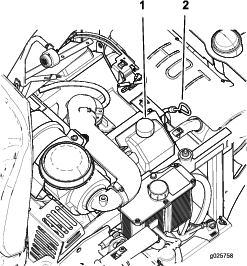
Changing the Engine Oil
| Maintenance Service Interval | Maintenance Procedure |
|---|---|
| Every 100 hours |
|
Note: Dispose of the used oil at a recycling center.
-
Park the machine so that the rear is slightly lower than the front to ensure that the oil drains completely.
-
Move the speed-control lever to the NEUTRAL position to stop the machine.
-
Disengage the PTO, engage the parking brake, shut off the engine, and wait for all moving parts to stop.
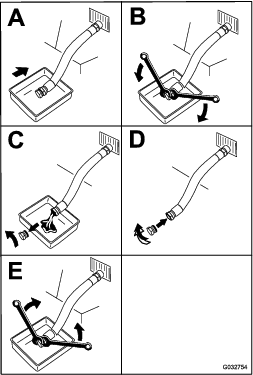
-
Slowly pour approximately 80% of the specified oil into the filler tube and slowly add the additional oil to bring it to the full mark on the dipstick (Figure 36).
-
Start the engine and drive to a flat area. Check the oil level again (Figure 36).
-
If needed, add oil to the full mark on the dipstick.
Changing the Engine-Oil Filter
| Maintenance Service Interval | Maintenance Procedure |
|---|---|
| Every 200 hours |
|
-
Drain the oil from the engine; refer to Changing the Engine Oil.
-
Change the engine-oil filter (Figure 38).
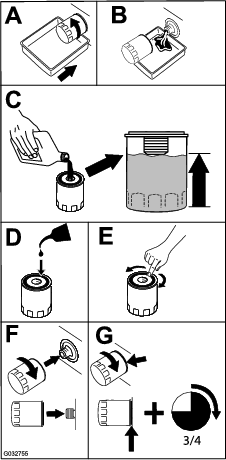
Note: Ensure that the oil-filter gasket touches the engine, and then turn the oil filter an extra 3/4 turn.
-
Fill the crankcase with the proper type of new oil (Engine-Oil Specifications.
Servicing the Spark Plugs
| Maintenance Service Interval | Maintenance Procedure |
|---|---|
| Every 200 hours |
|
| Every 500 hours |
|
Make sure that the air gap between the center and side electrodes is correct before installing the spark plugs. Use a spark-plug wrench for removing and installing the spark plugs and a gapping tool/feeler gauge to check and adjust the air gap. Install new spark plugs if necessary.
Type for EFI engines: Champion® XC12YC or equivalent
Type for Non-EFI engines: Champion® RC12YC or equivalent
Air Gap: 0.76 mm (0.030 inch)
Removing the Spark Plug
-
Park the machine on a level surface, disengage the blade-control switch (PTO), and engage the parking brake.
-
Shut off the engine, remove the key, and wait for all moving parts to stop before leaving the operating position.
-
Clean the area around the base of the plug to keep dirt and debris out of the engine.
-
Remove the spark plug (Figure 39).
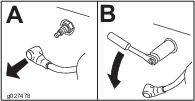
Checking the Spark Plug
Important: Do not clean the spark plug(s). Always replace the spark plug(s) when it has a black coating, worn electrodes, an oily film, or cracks.
If you see light brown or gray on the insulator, the engine is operating properly. A black coating on the insulator usually means the air cleaner is dirty.
Set the gap to 0.76 mm (0.03 inch).
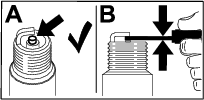
Installing the Spark Plug
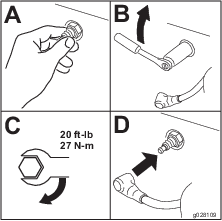
Checking the Spark Arrester
| Maintenance Service Interval | Maintenance Procedure |
|---|---|
| Every 50 hours |
|
Warning
Hot exhaust-system components may ignite fuel vapors even after you shut off the engine. Hot particles exhausted during engine operation may ignite flammable materials, resulting in personal injury or property damage.
Do not refuel or run the engine unless the spark arrester is installed.
-
Park the machine on a level surface, disengage the PTO, and engage the parking brake.
-
Shut off the engine, remove the key, and wait for all moving parts to stop before leaving the operating position.
-
Wait for the muffler to cool.
-
If you see any breaks in the screen or welds, replace the arrester.
-
If the screen is plugged, remove the arrester, shake loose particles out of the arrester, and clean the screen with a wire brush (soak the screen in solvent if necessary).
-
Install the arrester on the exhaust outlet.
Fuel System Maintenance
Warning
Fuel-system components are under high pressure. The use of improper components can result in system failure, fuel leakage, and possible explosion.
Use only approved fuel lines and fuel filters.
Servicing the Electronic Fuel-Injection System
This machine contains an electronic fuel-injection system. It controls the fuel flow under different operating conditions.
The electronic-control unit (ECU) continuously monitors the operation of the EFI system.
If a problem or fault within the system is detected, the malfunction-indicator light (MIL) illuminates. The MIL is the red light located in the right console panel.
Once the MIL illuminates, make initial troubleshooting checks; refer to the MIL section under .
If these checks do not correct the problem, further diagnosis and servicing by an Authorized Service Dealer is necessary.
Replacing the Fuel Filter
| Maintenance Service Interval | Maintenance Procedure |
|---|---|
| Every 200 hours |
|
The fuel filter is located near the engine on the front or rear side of the engine.
-
Park the machine on a level surface, move the speed-control lever to the NEUTRAL position, disengage the blade-control switch (PTO), and engage the parking brake.
-
Shut off the engine, remove the key, and wait for all moving parts to stop before leaving the operating position.
-
Allow the machine to cool down.
-
Clamp the hose on the fuel tank side of the fuel filter.
-
Replace the fuel filter (Figure 42).
Note: Ensure that the markings on the filter follow the fuel flow direction.
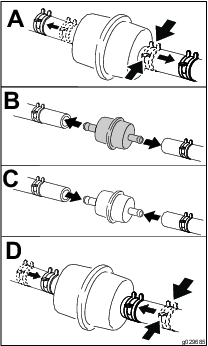
Note: Install the fuel-line hoses and secure them with plastic ties the same as they were originally installed at the factory to keep the fuel line away from components that could cause fuel line damage.
Servicing the Fuel Tank
Do not attempt to drain the fuel tank. Ensure that an Authorized Service Dealer drains the fuel tank and services any components of the fuel system.
Electrical System Maintenance
Electrical System Safety
-
Disconnect the battery before repairing the machine. Disconnect the negative terminal first and the positive last. Connect the positive terminal first and the negative last.
-
Charge the battery in an open, well-ventilated area, away from sparks and flames. Unplug the charger before connecting or disconnecting the battery. Wear protective clothing and use insulated tools.
Warning
Battery posts, terminals, and related accessories contain lead and lead compounds, chemicals known to the State of California to cause cancer and reproductive harm. Wash hands after handling.
Servicing the Battery
| Maintenance Service Interval | Maintenance Procedure |
|---|---|
| Monthly |
|
Danger
Battery electrolyte contains sulfuric acid which is fatal if consumed and causes severe burns.
Do not drink electrolyte and avoid contact with skin, eyes or clothing. Wear safety glasses to shield your eyes and rubber gloves to protect your hands.
Removing the Battery
Warning
Incorrectly removing the cables from battery could damage the machine and cables, causing sparks. Sparks can cause the battery gasses to explode, resulting in personal injury.
-
Always disconnect the negative (black) battery cable before disconnecting the positive (red) cable.
-
Always connect the positive (red) battery cable before connecting the negative (black) cable.
-
Park the machine on a level surface, move the speed-control lever to the NEUTRAL position, disengage the blade-control switch (PTO), and engage the parking brake.
-
Shut off the engine, remove the key, and wait for all moving parts to stop before leaving the operating position.
-
Disconnect the negative battery cable (black) from the negative (-) battery terminal (Figure 43).
-
Slide the red terminal boot off the positive (red) battery terminal and remove the positive (+) battery cable (Figure 43).
-
Remove the wing nuts securing the J-hooks (Figure 43).
-
Remove the clamp (Figure 43).
-
Remove the battery.
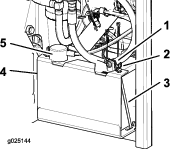
Charging the Battery
Warning
Charging the battery produces gasses that can explode.
Never smoke near the battery and keep sparks and flames away from the battery.
Important: Always keep the battery fully charged (1.265 specific gravity). This is especially important to prevent battery damage when the temperature is below 0°C (32°F).
-
Remove the battery from the chassis; refer to Removing the Battery.
-
Charge the battery for 10 to 15 minutes at 25 to 30 A or for 30 minutes at 10 A.
Note: Do not overcharge the battery.
-
When the battery is fully charged, unplug the charger from the electrical outlet, then disconnect the charger leads from the battery posts (Figure 44).
-
Install the battery in the machine and connect the battery cables; refer to Installing the Battery.
Note: Do not run the machine with the battery disconnected; electrical damage may occur.
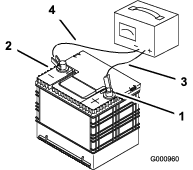
Installing the Battery
-
Position the battery in the tray with the terminal posts opposite from the hydraulic tank (Figure 43).
-
Install the positive (red) battery cable to the positive (+) battery terminal.
-
Install the negative (black) battery cable and ground wire to the negative (-) battery terminal.
-
Secure the cables with 2 bolts, 2 washers, and 2 locknuts (Figure 43).
-
Slide the red terminal boot onto the positive (red) battery post.
-
Install the clamp and secure it with the wing nuts and J-hooks (Figure 43).
Servicing the Fuses
The electrical system is protected by fuses. It requires no maintenance; however, if a fuse blows check the component/circuit for a malfunction or short.
-
The fuses are located on right side behind the seat.
-
To replace the fuses, pull out on the fuse to remove it.
-
Install a new fuse.
Adjusting the Safety Switches
Adjust all safety switches so that the plunger extends 4.8 mm to 6.4 mm (3/16 inch to 1/4 inch) from the switch body when the plunger is compressed (Figure 45).
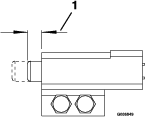
Jump-Starting the Machine
-
Check and clean corrosion from the battery terminals before jump-starting. Ensure that the connections are tight.
Caution
Corrosion or loose connections can cause unwanted electrical voltage spikes at any time during the jump-starting procedure.
Do not attempt to jump-start the machine with loose or corroded battery terminals, or damage to the engine or EFI may occur.
Danger
Jump-starting a weak battery that is cracked or frozen or has a low electrolyte level or an open/shorted battery cell can cause an explosion, resulting in serious personal injury.
Do not jump-start a weak battery if these conditions exist.
-
Make sure that the booster battery is a good and fully charged lead-acid battery at 12.6 V or greater.
Note: Use properly sized jumper cables with short lengths to reduce voltage drop between systems. Make sure that the cables are color coded or labeled for the correct polarity.
Caution
Connecting the jumper cables incorrectly (wrong polarity) can immediately damage the EFI system.
Be certain of battery-terminal polarity and jumper-cable polarity when hooking up the batteries.
Warning
Batteries contain acid and produce explosive gases.
-
Shield your eyes and face from the batteries at all times.
-
Do not lean over the batteries.
Note: Ensure that the vent caps are tight and level. Place a damp cloth, if available, over any vent caps on both batteries. Also ensure that the machines do not touch and that both electrical systems are off and at the same rated system voltage. These instructions are for negative ground systems only.
-
-
Connect the positive (+) cable to the positive (+) terminal of the discharged battery that is wired to the starter or solenoid as shown in Figure 46.
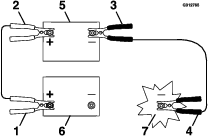
-
Connect the other end of the positive cable to the positive terminal of the booster battery.
-
Connect the black negative (–) cable to the other terminal (negative) of the booster battery.
-
Make the final connection on the engine block of the stalled machine (not to the negative battery post), away from the battery, and stand back (Figure 47).
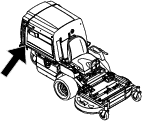

-
Start the machine and remove the cables in the reverse order of connection (disconnect the negative cable from the engine block first.).
Drive System Maintenance
Adjusting the Tracking
Note: The tracking knob is located under the seat.
Note: Rotating this knob allows fine tuning adjustments so that the machine tracks straight with the drive levers in the full forward position.
-
Run the machine at 3/4 speed for at least 5 minutes to bring hydraulic fluid up to operating temperature.
-
Park the machine on a level surface, move the speed-control lever to the NEUTRAL position, disengage the blade-control switch (PTO), and engage the parking brake.
-
Shut off the engine, remove the key, and wait for all moving parts to stop before leaving the operating position.
-
Tilt the seat forward to gain access to the tracking knob.
-
Rotate the knob toward the right to steer right and rotate it toward the left to steer left.
-
Adjust in 1/8 turn increments until the machine tracks straight.
-
Check and ensure that the machine does not creep when in neutral with the parking brakes disengaged (Figure 48).
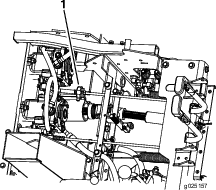
Checking the Tire Pressure
| Maintenance Service Interval | Maintenance Procedure |
|---|---|
| Every 40 hours |
|
Maintain the air pressure in the rear tires at 103 kPa (15 psi). Uneven tire pressure can cause uneven cut. Check the tires when they are cold, to get the most accurate pressure reading.
Note: The front tires are semi-pneumatic tires and does not require air pressure maintenance.
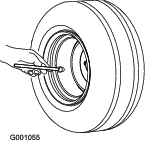
Note: Do not add any type of tire liner or foam fill material to the tires.
Checking the Wheel-Lug Nuts
| Maintenance Service Interval | Maintenance Procedure |
|---|---|
| After the first 100 hours |
|
| Every 500 hours |
|
Check and torque the wheel lug nuts to 122 to 129 N∙m (90 to 95 ft-lb).
Checking the Wheel-Hub Nuts
| Maintenance Service Interval | Maintenance Procedure |
|---|---|
| After the first 100 hours |
|
| Every 500 hours |
|
Check and ensure that the torque of the slotted nut is 373 to 475 N∙m (275 to 350 ft-lb).
Adjusting the Caster-Pivot Bearings
| Maintenance Service Interval | Maintenance Procedure |
|---|---|
| Every 500 hours |
|
-
Park the machine on a level surface, move the speed-control lever to the NEUTRAL position, disengage the blade-control switch (PTO), and engage the parking brake.
-
Shut off the engine, remove the key, and wait for all moving parts to stop before leaving the operating position.
-
Remove the dust cap from the caster and tighten the locknut until the spring washers are flat, then back off 1/4 turn to properly set the pre-load on the bearings (Figure 50 and Figure 51).
Important: Make sure that the spring washers are installed correctly as shown in Figure 50 and Figure 51.
-
Install the dust cap.
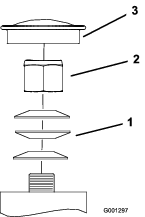
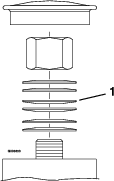
Cooling System Maintenance
Cleaning the Engine Screen and Engine-Oil Cooler
| Maintenance Service Interval | Maintenance Procedure |
|---|---|
| Before each use or daily |
|
Remove any buildup of grass, dirt, or other debris from the oil cooler and the engine screen. This helps ensure adequate cooling and correct engine speed and reduces the possibility of overheating and mechanical damage to the engine.
Servicing the Engine-Oil Cooler
| Maintenance Service Interval | Maintenance Procedure |
|---|---|
| Every 100 hours |
|
-
Park the machine on a level surface, move the speed-control lever to the NEUTRAL position, disengage the PTO, and engage the parking brake.
-
Shut off the engine, remove the key, and wait for all moving parts to stop before leaving the operating position.
-
Remove the fuel-tank mounting nuts and swing out the fuel tank.
-
Keep the oil-cooler free of debris by cleaning the fins with a brush.
-
Swing the fuel tank in and secure it with the mounting nuts.
-
Back the mounting nuts off 1/2 turn to allow for tank expansion.
Cleaning the Engine Cooling Fins and Shrouds
| Maintenance Service Interval | Maintenance Procedure |
|---|---|
| Every 100 hours |
|
-
Park the machine on a level surface, move the speed-control lever to the NEUTRAL position, disengage the PTO, and engage the parking brake.
-
Shut off the engine, remove the key, and wait for all moving parts to stop before leaving the operating position.
-
Remove the air-intake screen and fan housing.
-
Clean the debris and grass from the engine parts.
-
Install air-intake screen and fan housing.
Checking and Cleaning the Hydraulic Pumps
| Maintenance Service Interval | Maintenance Procedure |
|---|---|
| Before each use or daily |
|
-
Park the machine on a level surface, move the speed-control lever to the NEUTRAL position, disengage the PTO, and engage the parking brake.
-
Shut off the engine, remove the key, and wait for all moving parts to stop before leaving the operating position.
-
Raise the seat.
-
Clean the debris and grass from the hydraulic pumps.
-
Lower the seat.
Brake Maintenance
Adjusting the Parking Brake
| Maintenance Service Interval | Maintenance Procedure |
|---|---|
| After the first 100 hours |
|
| Every 500 hours |
|
Make sure that the brake is adjusted properly. Follow this procedure when you remove or replace a brake component.
-
Park the machine on a level surface, move the speed-control lever to the NEUTRAL position, disengage the PTO, and engage the parking brake.
-
Shut off the engine, remove the key, and wait for all moving parts to stop before leaving the operating position.
-
Release the parking brake.
-
Tilt the seat forward.
-
Check and ensure that there is no slack between the parking-brake handle and the linkage.
-
If an adjustment is necessary, remove the clevis pin and rotate the linkage counterclockwise to lengthen it or clockwise to shorten it.
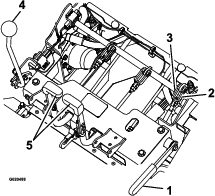
-
Measure the compressed spring length on both vertical spring assemblies.
Note: The spring should measure between 6 to 7 cm (2.35 to 2.85 inches). If necessary, adjust the nut at the top of the vertical spring assembly to achieve this distance.
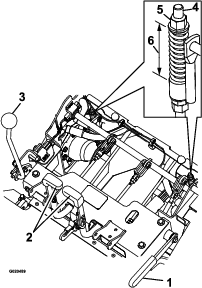
-
Adjust the linkage length with the 2 nuts at the bottom of the vertical spring assembly (Figure 54).
Note: The linkage should measure 22.7 to 23.3 cm (8.92 to 9.16 inches).

-
Engage and disengage the brakes to check for proper engagement and disengagement. Adjust if necessary.
Note: When the brakes are disengaged, there should be little to no free play in the brake linkage with no dragging in the brakes.
Belt Maintenance
Inspecting the Belts
| Maintenance Service Interval | Maintenance Procedure |
|---|---|
| Every 40 hours |
|
-
Park the machine on a level surface, move the speed-control lever to the NEUTRAL position, disengage the PTO, and engage the parking brake.
-
Shut off the engine, remove the key, and wait for all moving parts to stop before leaving the operating position.
-
Tilt the hopper up and check the pump and PTO drive belts for wear, cracking, or contamination.
Note: The belts are spring tensioned and no adjustment is necessary unless the belts are replaced.
Replacing the PTO Belts
-
Park the machine on a level surface, move the speed-control lever to the NEUTRAL position, disengage the PTO, and engage the parking brake.
-
Shut off the engine, remove the key, and wait for all moving parts to stop before leaving the operating position.
-
With the engine off, engage the PTO lever, then remove the hairpin cotter and clevis pin at the bottom of the PTO-brake band.
-
Rotate the brake band upward and out of the way of the belts keeping clear of the belt drive.
-
Disengage the PTO lever.
-
Loosen belt guides A and B (Figure 55).
-
Remove the belts.
-
Route the new belts onto the pulleys as shown in Figure 55.
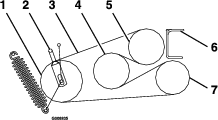
-
Engage the PTO lever.
-
Rotate the brake band down into the original position.
-
Install the clevis pin and hairpin cotter to secure the brake band.
-
Loosen the jam nuts and adjust the linkage until the top of the idler arm is aligned with the bottom of the notch on the tension arm as shown in Figure 56.
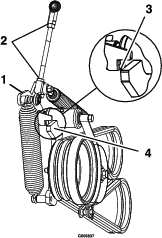
-
Tighten the jam nuts and disengage the PTO lever.
-
Engage the PTO lever and check the alignment.
-
Check and adjust the belt guides as stated in Adjusting the Belt Guides.
Replacing the Pump-Drive Belt
-
Park the machine on a level surface, move the speed-control lever to the NEUTRAL position, disengage the PTO, and engage the parking brake.
-
Shut off the engine, remove the key, and wait for all moving parts to stop before leaving the operating position.
-
Remove the PTO Belts; refer to Replacing the PTO Belts.
-
Pull the spring idler or remove the spring to relieve the tension of the pump-drive belt.
-
Remove the old belt.
-
Route the new belt onto the sheaves as shown in the decal located on the back of the left drive shield (Figure 57).
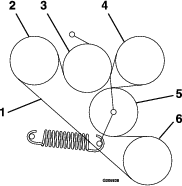
-
Install the PTO belts; refer to Replacing the PTO Belts.
Adjusting the Belt Guides
-
Park the machine on a level surface, move the speed-control lever to the NEUTRAL position, disengage the PTO, and engage the parking brake.
-
Shut off the engine, remove the key, and wait for all moving parts to stop before leaving the operating position.
-
With the engine off, engage the PTO lever.
-
Adjust the belt guides as shown in Figure 58.
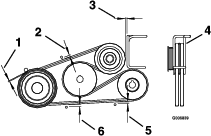
Controls System Maintenance
Aligning the PTO-Drive Pulley
Align the PTO-drive pulley for any of the following conditions:
-
The blower has been removed or replaced.
-
The engine mounting bolts have been loosened or the engine has been moved or replaced.
-
The jackshaft mounting bolts have been loosened or the jackshaft has been moved or replaced.
-
Park the machine on a level surface, move the speed-control lever to the NEUTRAL position, disengage the blade-control switch (PTO), and engage the parking brake.
-
Shut off the engine, remove the key, and wait for all moving parts to stop before leaving the operating position.
-
Remove the fuel-tank mounting nuts and swing out the fuel tank.
-
Verify that the blower is installed and tightly secured.
-
Loosen the 4 engine mounting bolts.
-
Unhook the pump-belt tension spring.
-
Loosen the 4 jackshaft mounting bolts.
-
Measuring from the blower pulley as a baseline, move the engine and jackshaft until the rear surface of all 3 pulleys are aligned within 0.8 to 1.6 mm (1/32 inch to 1/16 inch) (Figure 59).
Note: Use a straight edge to align all 3 surfaces.
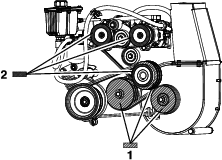
-
Tighten the 4 engine mounting bolts and 4 jackshaft mounting bolts. Check the alignment after tightening.
-
Install the pump-belt tension spring.
-
Swing the fuel tank in and install the tank mounting nuts.
-
Align the pump-drive pulley; Aligning the Pump-Drive Pulley.
Aligning the Pump-Drive Pulley
The pump-drive-pulley alignment is necessary for any of the following conditions:
-
The engine mounting bolts have been loosened or the engine has been moved or replaced.
-
The pump pulleys have been loosened, moved, or replaced.
-
The PTO pulley has been aligned; refer to Aligning the Pump-Drive Pulley.
-
Park the machine on a level surface, move the speed-control lever to the NEUTRAL position, disengage the blade-control switch (PTO), and engage the parking brake.
-
Shut off the engine, remove the key, and wait for all moving parts to stop before leaving the operating position.
-
Loosen the set screws on both pump pulleys.
-
Using a straight edge, align each pump pulley with the engine pulley by sliding it along the pump shaft (Figure 59).
-
Tighten the pulley set screws and check the alignment.
Adjusting the PTO Brake Spring
Adjust the PTO brake spring only if the blower has been removed or replaced or if the PTO drive idler arm has been disassembled.
-
Park the machine on a level surface, move the speed-control lever to the NEUTRAL position, disengage the blade-control switch (PTO), and engage the parking brake.
-
Shut off the engine, remove the key, and wait for all moving parts to stop before leaving the operating position.
-
Locate the brake spring and thread the 2 jam nuts out to the end of the brake-spring rod (Figure 60).
-
Tighten the jam nuts together at end of the brake-spring rod.
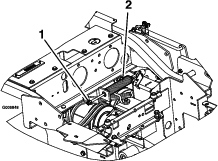
Adjusting the Hopper Door
-
Park the machine on a level surface, move the speed-control lever to the NEUTRAL position, disengage the blade-control switch (PTO), and engage the parking brake.
-
Shut off the engine, remove the key, and wait for all moving parts to stop before leaving the operating position.
-
Loosen the 6 door hinge nuts (Figure 61).
-
Open the door and place a 3/8 inch (9.5 mm) rubber strip or 3/8 inch (9.5 mm) diameter hose between the hopper and the hopper door (Figure 61).
-
Close the door and push it tight against the hopper.
-
Tighten the hinge hardware.
-
Open the hopper door and remove the rubber strip.
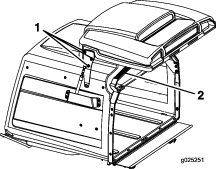
Hydraulic System Maintenance
Hydraulic System Safety
-
Seek immediate medical attention if fluid is injected into skin. Injected fluid must be surgically removed within a few hours by a doctor.
-
Ensure that all hydraulic-fluid hoses and lines are in good condition and all hydraulic connections and fittings are tight before applying pressure to the hydraulic system.
-
Keep your body and hands away from pinhole leaks or nozzles that eject high-pressure hydraulic fluid.
-
Use cardboard or paper to find hydraulic leaks.
-
Safely relieve all pressure in the hydraulic system before performing any work on the hydraulic system.
Servicing the Hydraulic System
Hydraulic Fluid Type: Toro® HYPR-OIL™ 500 hydraulic oil or Mobil® 1 15W-50.
Important: Use the fluid specified. Other fluids could cause system damage.
Checking the Hydraulic Fluid
| Maintenance Service Interval | Maintenance Procedure |
|---|---|
| Every 40 hours |
|
-
Park the machine on a level surface, move the speed-control lever to the NEUTRAL position, disengage the blade-control switch (PTO), and engage the parking brake.
-
Shut off the engine, remove the key, and wait for all moving parts to stop before leaving the operating position.
-
Allow the engine and the hydraulic system to cool for 10 minutes.
Note: To get the correct reading, check the hydraulic fluid level when the machine is cool.
-
Raise the seat up.
-
Clean the area around the dipstick of the hydraulic-system reservoir (Figure 62).
-
Remove the dipstick from the hydraulic reservoir (Figure 62).
-
Wipe the dipstick off and thread the dipstick into the reservoir.
-
Remove the dipstick and look at the end (Figure 62). If the fluid level is at the add mark, slowly pour only enough fluid into the hydraulic reservoir to raise the level to the full line.
Important: Do not overfill the hydraulic units with fluid, as damage may occur. Do not run the machine with the fluid below the add mark.
-
Install the dipstick.

Replacing the Hydraulic Fluid and Filter
| Maintenance Service Interval | Maintenance Procedure |
|---|---|
| After the first 100 hours |
|
| Every 250 hours |
|
| Every 500 hours |
|
Note: Use a summer filter when the temperature is 0°C (32°F) and above. Use a winter filter when the temperature is 0°C (32°F) and below.
-
Park the machine on a level surface, move the speed-control lever to the NEUTRAL position, disengage the blade-control switch (PTO), and engage the parking brake.
-
Shut off the engine, remove the key, and wait for all moving parts to stop before leaving the operating position.
-
Carefully clean the area around the filter.
Important: Ensure that no dirt or contamination enter the hydraulic system.
-
Unscrew and remove the filter and allow the fluid to drain from the reservoir.
Important: Do not change the hydraulic system fluid (except for what can be drained when changing the filter), unless the fluid has been contaminated or been extremely hot. Changing the hydraulic fluid unnecessarily could damage the hydraulic system by introducing contaminates into the system.
-
Before installing the new filter, fill it with Toro® HYPR-OIL™ 500 hydraulic fluid and apply a thin coat of fluid on the surface of the rubber seal.
-
Turn the filter clockwise until the rubber seal contacts the filter adapter, then tighten the filter an additional 2/3 to 3/4 turn.
-
Fill the reservoir as stated in Checking the Hydraulic Fluid.
-
Raise the rear of the machine up and support it with jack stands (or equivalent support) just high enough to allow drive wheels to turn freely.
-
Start the engine and move the throttle control to the FULL-THROTTLE position.
-
Move the speed-control levers to the full-speed position and run the machine for several minutes.
-
Shut off the machine and check the fluid level.
Mower Deck Maintenance
Leveling the Mower Deck
Leveling the Deck
-
Park the machine on a level surface, move the speed-control lever to the NEUTRAL position, disengage the blade-control switch (PTO), and engage the parking brake.
-
Shut off the engine, remove the key, and wait for all moving parts to stop before leaving the operating position.
-
Check the tire pressure in the drive tires; refer to Checking the Tire Pressure.
-
Verify that all hairpin cotters are in the 7.62 cm (3 inch) mower-deck-height holes with the spacers under the hairpin cotters (Figure 63).
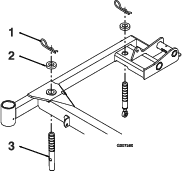
-
Shorten or lengthen each mower deck support pin to obtain blade tip height of 7.62 cm (3 inches) at the front of the deck and 8.26 cm (3 1/4 inches) at the rear of the deck (Figure 63).
Note: The front pins are thread into the mower deck and have a jam nut. The rear pins have a rod end threaded into them with a jam nut.
Servicing the Cutting Blades
To ensure a superior quality of cut, keep the blades sharp. For convenient sharpening and replacement, you may want to keep extra blades on hand.
Blade Safety
A worn or damaged blade can break, and a piece of the blade could be thrown toward you or bystanders, resulting in serious personal injury or death. Trying to repair a damaged blade may result in discontinued safety certification of the product.
-
Inspect the blades periodically for wear or damage.
-
Use care when checking the blades. Wrap the blades or wear gloves, and use caution when servicing the blades. Only replace or sharpen the blades; never straighten or weld them.
-
On multi-bladed machines, take care as rotating 1 blade can cause other blades to rotate.
Before Inspecting or Servicing the Blades
-
Park the machine on a level surface, disengage the blade-control switch (PTO), and engage the parking brake.
-
Shut off the engine, remove the key, and disconnect the spark-plug wires from the spark plugs.
Inspecting the Blades
| Maintenance Service Interval | Maintenance Procedure |
|---|---|
| Before each use or daily |
|
-
Inspect the cutting edges (Figure 64).
-
If the edges are not sharp or have nicks, remove and sharpen the blade; refer to Sharpening the Blades.
-
Inspect the blades, especially in the curved area.
-
If you notice any cracks, wear, or a slot forming in this area, immediately install a new blade (Figure 64).
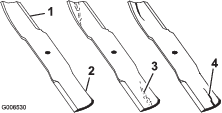
Checking for Bent Blades
-
Rotate the blades until the ends face forward and backward.
-
Measure from a level surface to the cutting edge, position A, of the blades (Figure 65).
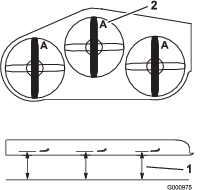
-
Rotate the opposite ends of the blades forward.
-
Measure from a level surface to the cutting edge of the blades at the same position as in step 2 above.
Note: The difference between the dimensions obtained in steps 2 and 4 must not exceed 3 mm (1/8 inch).
Note: If this dimension exceeds 3 mm (1/8 inch), the blade is bent and must be replaced.
Removing the Blades
Replace the blades if they hit a solid object, or if the blade is out of balance or bent.
Note: Make note of the red-colored blade position. From the normal user position, it is located on the right side.
-
Lift the mower deck and secure in the raised position. Refer to Raising the Mower Deck into the Service Position.
-
Hold the blade end using a rag or thickly padded glove.
-
Remove the blade, washer, and blade bolt that secures the blade and blade driver (Figure 66).
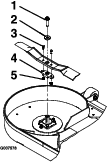
-
Remove the blade driver from the existing blade (Figure 66).
Sharpening the Blades
-
Use a file to sharpen the cutting edge at both ends of the blade (Figure 67).
Note: Maintain the original angle.
Note: The blade retains its balance if the same amount of material is removed from both cutting edges.

-
Check the balance of the blade by putting it on a blade balancer (Figure 68).
Note: If the blade stays in a horizontal position, the blade is balanced and can be used.
Note: If the blade is not balanced, file some metal off the end of the sail area only (Figure 67).

-
Repeat this procedure until the blade is balanced.
Installing the Blades
Note: Ensure that you install the red-colored blade on the right side.
-
Install the blade driver to the new blades with the shear bolts and locknuts (Figure 66).
-
Torque the shear bolts to 922 to 1130 N∙m (80 to 100 in-lb).
Note: Align the blade-driver flats with the flats on the shaft when installing the blade on the mower deck.
-
Install the blade, washer, and blade bolt to the spindle shaft (Figure 66).
-
Torque the blade bolt to 115 to 149 N∙m (85-110 ft-lb).
-
Lower the mower deck to the operating position. Refer to Lowering the Mower Deck to the Operating Position.
Warning
Operating a mower deck with loose or weakened blade bolts can be dangerous. A loose or weakened blade bolt could allow a blade rotating at a high speed to come out from under the mower deck, causing serious injury or property damage.
-
Replace the blade bolt after striking a foreign object.
-
Use only genuine Toro replacement parts.
-
Do not lubricate the threads of the bolt or spindle before assembly.
-
Removing the Mower Deck
Warning
Operating this machine without an approved Toro front mount attachment increases the possibility of operator entanglement in the drive wheels or forward tip-over. Entanglement or tip-over could cause serious injury or death.
When operating this machine without an approved Toro front mount attachment, observe the following:
-
Keep feet and clothing away from tires.
-
Limit operation to minimum required to install a different front mount attachment.
-
Minimize speed and use extreme caution.
-
Only operate on a flat level surface.
-
Do not operate up or down a trailer ramp.
-
Avoid sudden acceleration or deceleration.
Important: Do not transport this machine without an approved Toro front mount attachment.
-
Park the machine on a level surface, move the speed-control lever to the NEUTRAL position, disengage the blade-control switch (PTO), and engage the parking brake.
-
Shut off the engine, remove the key, and wait for all moving parts to stop before leaving the operating position.
-
Raise the mower deck up and latch it with the deck-locking pins. Refer to Raising the Mower Deck into the Service Position.
-
Remove the hairpin cotters and washers at the top of the deck-lift-assist spring on each side of the machine (Figure 69).
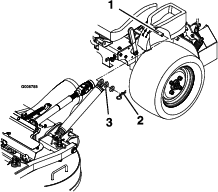
-
Remove the spring from the spring anchor. Repeat for other side of the machine.
-
Unlatch the mower deck from the raised position and slowly lower the mower deck to ground; refer to Lowering the Mower Deck to the Operating Position.
Note: The mower deck becomes heavier when you remove the springs from the anchors. Lower the mower deck carefully.
-
Remove the lynch pins at front of push arms on both sides of the machine (Figure 70).
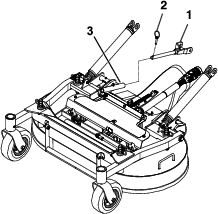
-
Remove the hairpin cotter and clevis pin from both sides of the PTO guard (Figure 71).

-
Raise the seat and disconnect the drive shaft using the quick coupler at the jackshaft (Figure 72).
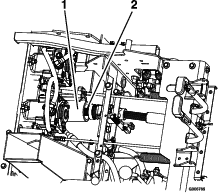
-
Pull the mower deck forward to remove it from the machine.
Installing the Mower Deck
Important: Do not transport the machine without an approved Toro front mount attachment.
-
Park the machine on a level surface, move the speed-control lever to the NEUTRAL position, disengage the blade-control switch (PTO), and engage the parking brake.
-
Shut off the engine, remove the key, and wait for all moving parts to stop before leaving the operating position.
-
Roll the mower deck up to the machine with the discharge tube down, making sure that the deck springs are located above the drive wheel and below the console on each side.
-
Raise the seat and install the drive shaft onto the jackshaft (Figure 72)
-
Align the mower-deck push-arm tubes to the machine push-arms and push the mower deck rearward.
-
Secure the push arms with the lynch pins on the left and right sides of the machine (Figure 70).
-
Align the upper portion of the rubber PTO guard to the tabs on the front of the console and secure with a clevis pin and hairpin cotter on each side (Figure 71).
-
Release the mower-deck locking pins on each side, raise the mower deck to the service position, and secure the deck latch onto hook. Refer to Raising the Mower Deck into the Service Position.
-
Install the springs onto the spring anchor pins under the left and right consoles and secure with a washer and hairpin cotter (Figure 69).
-
Unlatch the mower deck from the raised position, slowly lower the mower deck to ground, and lock the deck-locking pins on each side. Refer to Lowering the Mower Deck to the Operating Position.
Adjusting the Locking-Pin Stop on the Mower Deck
-
Slide the mower-deck locking pins in on both sides and rotate to lock the deck in the operating position.
-
Loosen the jam nut and turn the stop screw clockwise until the locking pin is tight and cannot be rotated by hand (Figure 73).
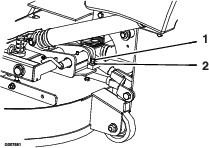
-
Loosen the stop screw counter clockwise 1/2 turn and tighten the jam nut.
-
Test the locking pin to make sure it slides freely. Adjust it if necessary.
Cleaning
Cleaning under the Mower
| Maintenance Service Interval | Maintenance Procedure |
|---|---|
| Before each use or daily |
|
-
Park the machine on a level surface, move the speed-control lever to the NEUTRAL position, disengage the blade-control switch (PTO), and engage the parking brake.
-
Shut off the engine, remove the key, and wait for all moving parts to stop before leaving the operating position.
-
Lift the mower deck and secure it in the raised position. Refer to Raising the Mower Deck into the Service Position.
-
Clean any grass buildup under the mower deck.
-
Lower the mower deck to the operating position. Refer to Lowering the Mower Deck to the Operating Position.
Cleaning Debris from the Machine
| Maintenance Service Interval | Maintenance Procedure |
|---|---|
| Before each use or daily |
|
-
Park the machine on a level surface, move the speed-control lever to the NEUTRAL position, disengage the blade-control switch (PTO), and engage the parking brake.
-
Shut off the engine, remove the key, and wait for all moving parts to stop before leaving the operating position.
-
Clean off any oil, debris, or grass buildup on the machine, especially around the fuel tank, engine, and exhaust area.
Disposing of Waste
Engine oil, batteries, hydraulic fluid, and engine coolant are pollutants to the environment. Dispose of these according to your state and local regulations.
Storage
Storage Safety
-
Let the engine cool before storing the machine.
-
Do not store the machine or fuel near flames or drain the fuel indoors.
Cleaning and Storage
-
Disengage the blade-control switch (PTO), and engage the parking brake.
-
Shut off the engine, remove the key, and wait for all moving parts to stop before leaving the operating position.
-
Remove grass clippings, dirt, and grime from the external parts of the entire machine, especially the engine and hydraulic system. Clean dirt and chaff from the outside of the engine cylinder head fins and blower housing.
Important: You can wash the machine with mild detergent and water. Do not pressure wash the machine. Avoid excessive use of water, especially near the control panel, engine, hydraulic pumps, and motors.
-
Check the parking brake operation; refer to Operating the Parking Brake.
-
Service the air cleaner; refer to Servicing the Air Cleaner.
-
Grease the machine; refer to Lubrication.
-
Change the crankcase oil; refer to Changing the Engine Oil.
-
Check the tire pressure; refer to Checking the Tire Pressure.
-
Change the hydraulic filters; refer to Replacing the Hydraulic Fluid and Filter.
-
Charge the battery; refer to Charging the Battery.
-
Scrape any heavy buildup of grass and dirt from the underside of the mower, then wash the mower with a garden hose.
Note: Run the machine with the blade-control switch (PTO) engaged and the engine at high idle for 2 to 5 minutes after washing.
-
Check the condition of the blades; refer to Servicing the Cutting Blades.
-
Prepare the machine for storage when non-use occurs over 30 days. Prepare the machine for storage as follows:
-
Add a petroleum based stabilizer/conditioner to fuel in the tank. Follow mixing instructions from the stabilizer manufacturer. Do not use an alcohol-based stabilizer (ethanol or methanol).
Note: A fuel stabilizer/conditioner is most effective when mixed with fresh fuel and used at all times.
-
Run the engine to distribute conditioned fuel through the fuel system (5 minutes).
-
Shut off the engine, allow it to cool, and drain the fuel tank.
-
Start the engine and run it until it stops.
-
Dispose of fuel properly. Recycle the fuel according to local codes.
Important: Do not store fuel containing stabilizer/conditioner longer than the duration recommended by the fuel-stabilizer manufacturer.
-
-
Remove and check the condition of the spark plug(s); refer to Servicing the Spark Plugs. With the spark plug(s) removed from the engine, pour 30 ml (2 tablespoons) of engine oil into the spark plug hole. Use the starter to crank the engine and distribute the oil inside the cylinder. Install the spark plug(s). Do not install the wire on the spark plug(s).
-
Check and tighten all bolts, nuts, and screws. Repair or replace any part that is damaged.
-
Paint all scratched or bare metal surfaces. Paint is available from your Authorized Service Dealer.
-
Store the machine in a clean, dry garage or storage area. Remove the key from the switch and keep it out of reach of children or other unauthorized users. Cover the machine to protect it and keep it clean.
Troubleshooting
| Problem | Possible Cause | Corrective Action |
|---|---|---|
| The malfunction-indicator light (MIL) comes on. |
|
|
| The starter does not crank. |
|
|
| The engine does not start, starts hard, or fails to keep running. |
|
|
| The engine loses power. |
|
|
| The engine overheats. |
|
|
| The mower pulls left or right (with levers fully forward). |
|
|
| The machine does not drive. |
|
|
| The machine vibrates abnormally. |
|
|
| The machine produces an uneven cutting height. |
|
|
| The blades do not rotate. |
|
|
Schematics
Wire Diagram (Non-EFI machines)
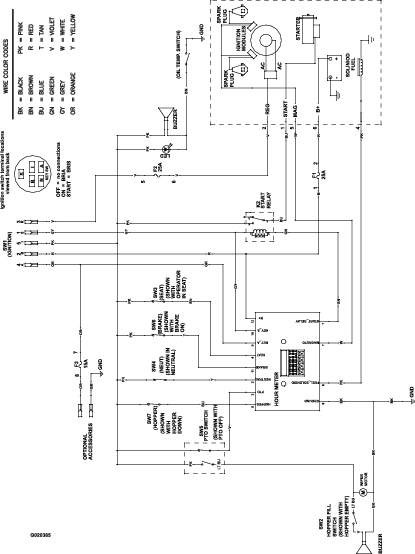
Wire Diagram (EFI machines)
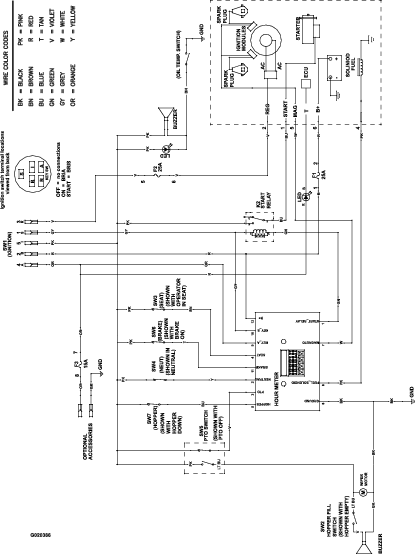
Hydraulic Diagram
